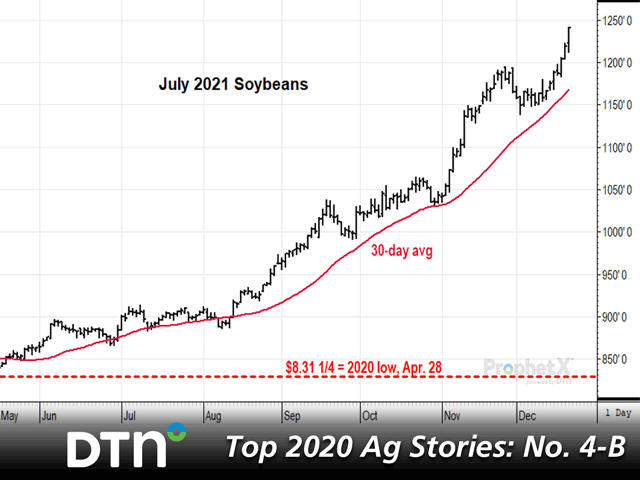Top 10 Ag Stories of 2020 - 4 (B)
A Year Without Comparison, Part B
OMAHA (DTN) -- Each year, DTN publishes our choices for the top 10 ag news stories of the year, as selected by DTN analysts, editors and reporters. Today, we continue the countdown with No. 4 -- in this case, Part B of No. 4.
Editor's Note: DTN Lead Analyst Todd Hultman walks us through the tumultuous 2020 marketing year in this two-part package, A Year Without Comparison. This second piece follows up on the April crash in oil prices through the pleasant surprise of post-harvest grain price bullishness.
A video of Hultman's outlook for 2021 is available to those who registered for the DTN Ag Summit on the Ag Summit digital platform at: https://dtnagsummit.psav.live/…
There is still time to register and catch all the DTN Ag Summit content through Jan. 8 at: dtn.com/agsummit2020
**
As we began to learn about spring planting through a pandemic, crude oil prices gave us another new experience, going into negative price territory that sent shockwaves through all markets.
Seven days after May crude oil contract prices fell to a historic low of minus $40.32, USDA reported 27% of corn and 8% of soybeans were planted, off to a much better start in 2020 than the disastrous planting experience of 2019. Little did anyone know November soybean prices had already put in their 2020 low of $8.31 on April 21.
Planting went so well in the spring, 93% of corn and 75% of soybeans were in the ground by the end of May, among the quickest starts in years. For price outlooks, the favorable planting weather was a bearish curse as USDA estimated 3.32 billion bushels (bb) of ending corn stocks for 2020-21, based on a crop of nearly 16.0 bb. USDA's average farm price estimate was $3.20 a bushel, but historical comparisons pointed at cash corn prices well below $3.00. USDA's estimate of soybean prices for 2020-21 was no better, pegged at $8.20 a bushel.
Except for a dry area in west-central Iowa, the early growing season of 2020 had few complaints. On Aug. 10, USDA reported 71% of corn and 74% of soybeans were rated good to excellent. For soybeans, it was the highest such rating in at least 10 years as pods were about to set.
Aug. 10 is now also remembered as the day of the derecho, a wide swath of hurricane-like, crop-damaging winds that swept into Iowa from South Dakota and Nebraska and eventually reached seven states. The derecho laid miles of corn fields flat across Iowa; it also marked the start of a dry finish for 2020 row crops.
USDA's corn crop estimate of 14.51 bb in December was nearly 1.50 bb lower than the June estimate, trimmed by a lower planting estimate, the August derecho and late-season hit of dry weather. USDA estimated the soybean crop at 4.425 bb in August, but dry weather brought the estimate down to 4.17 bb by December.
Had the late-season crop reductions been the only bullish influences on corn and soybean prices in 2020, we'd probably still be looking at corn in the low $3s and soybeans below $9.00, but a much stronger bullish movement was taking place, of which we in the U.S. were unaware. China, it turns out, was starting to buy massive amounts of feed grain and soybeans, likely experiencing a shortage of feed at home.
P[L1] D[0x0] M[300x250] OOP[F] ADUNIT[] T[]
I say "likely" because we in the U.S. have no verifiable access to China's grain supply information, so we had no early warning system in place. So far in 2020-21, China has bought 455 mb of corn from the U.S., the bulk of which took place when cash corn was under $3.50.
China has bought 1.17 bb of U.S. soybeans to date, over three-fourths of which were purchased when cash soybeans were below $10 a bushel. The unexpected buying sparked strong bullish moves in both corn and soybeans that probably are not over yet.
USDA now estimates U.S. ending corn stocks at 1.70 bb and ending soybean stocks at 175 mb, the lowest in seven years. With U.S. soybean export commitments currently at 1.99 bb and domestic demand for crush staying strong, U.S. soybean supplies are apt to go much lower than 175 mb and the U.S. may need to import soybeans this summer.
From a technical perspective, July 2021 corn remains in an uptrend, priced at $4.50 on Dec. 24 and is holding above its 30-day average at $4.32. July 2021 soybeans are also in an uptrend, priced at $12.57 and are holding above their 30-day average at $11.80.
If Part B of this review of 2020 sounds completely different than Part A, you are not imagining things. The two halves of 2020 could not be more different, and I have no problem saying that after 35 years in the business, I have never seen a year that comes close to the extremes and unexpected changes we witnessed in 2020.
It is difficult to say at this point that everything will be fine in 2021, because we do have a serious problem of short soybean supplies in the U.S. We also have large areas of drought forming in the western U.S., a potential problem in spring.
I can't say everything will go back to normal in 2021, but my goodness, it's difficult to imagine a more dramatic year than what we just survived.
**
Editor's Note:
You can find No. 3 in DTN's top 10 list on Dec. 29.
See Best of the Rest here: https://www.dtnpf.com/…
See No. 10 here: https://www.dtnpf.com/…
See No. 9 here:
See No. 8 here: https://www.dtnpf.com/…
See No. 7 here:
See No. 6 here:
See No. 5 here:
See No. 4 (Part A) here:
Todd Hultman can be reached at Todd.Hultman@dtn.com
Follow him on Twitter @ToddHultman1
(c) Copyright 2020 DTN, LLC. All rights reserved.




